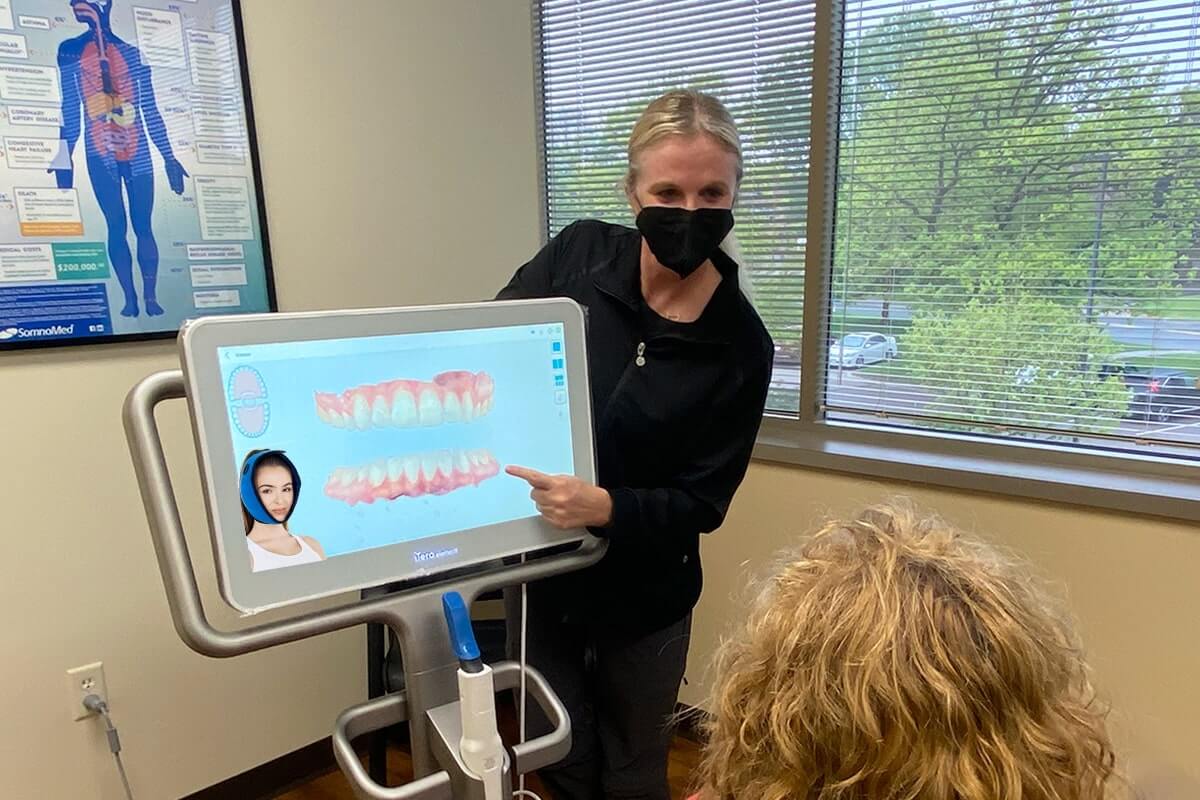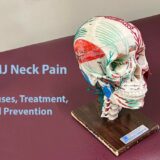Is Heat or Ice Better for Jaw Pain?

Is Heat or Ice Better for Jaw Pain?
Whether heat or cold will help you more may depend on the source of your jaw pain.
TMD symptoms can be challenging to manage. If you struggle with finding jaw pain solutions, you should know the risks if left undiagnosed and treated. Many try to manage pain by using a home remedy. This may be a place to start but when more relief is needed in the long run – be quick to seek professional help.
People with a temporomandibular joint disorder, or TMJ for short, are all too familiar with jaw pain. If you don’t have a diagnosis yet and you’re at home or at work needing your jaw to stop hurting, you may reduce temporary jaw discomfort with the simple home remedy of applying hot or cold compresses.
Let’s answer common questions about if and how hot and cold packs work to provide relief from jaw pain.
Can Hot and Cold Packs Relieve TMD Pain?
Yes! Hot and cold packs work to help alleviate TMD aches and pains people often experience. However, they do not treat symptoms of TMD. However, they do not treat causes of TMD pain.
Ice helps decrease swelling and pain, while heat can increase blood flow and relax your jaw muscles. The knowledge of when to use heat or ice can make a significant difference. You may shorten a jaw trauma injury’s recovery time and help with chronic aches, pains, and stiffness by knowing when heat or ice for jaw pain is better.
Treating an injury is best with a professional diagnosis. Not all jaw pain conditions require strictly ice or heat therapy. In some cases, both ice therapy and heat therapy have a timely role in the healing process. Generally speaking, ice therapy is more appropriate for new injuries, such as jaw sprains and strains, whereas heat therapy is typically better for treating chronic conditions. In addition to heat or ice, some gentle stretching the jaw can help improve the pain.
When is ice best for reducing jaw pain?
Apply ice to your jaw if swelling or inflammation is present. This may be triggered by a recent sports injury, car accident, or dental trauma. Icing your jaw when you’re already shivering isn’t logical. The cold constricts blood vessels and decreases circulation to the inflamed jaw area. Using a cold compress or ice pack on a strained jaw muscle can also numb pain in the area. On the other hand, heat can make jaw inflammation significantly worse.
How to use ice for reducing jaw pain?
Apply ice 3-4 times per day for the initial 3 days. After 3 days, moist heat may be best, following the same schedule, for 1 week. We generally suggest applying a cold compress to your jaw for 10 to 15 minutes at a time using a light layer between the compress and your skin. If you go longer and more often, it may start to cause some damage.
Remember, icing a sprained or strained jaw for longer than 20 minutes at a time is not recommended. Some pain patients may simply need a single daily icing while more severe sprains and strains may require multiple daily ice therapy applications. Follow the guidance of your specialist.
When is heat best for reducing jaw pain?
If your jaw pain generates from muscle pain, tightness, or stiffness, heat compression will be a better option. Ice can aggravate symptoms of tightness and stiffness; it can also worsen unwanted pain.
Heat therapy may not be best for individuals who are pregnant or people suffering from peripheral vascular disease, diabetes, heart disease, hypertension, deep vein thrombosis, and other medical conditions. If experiencing unusual or extended jaw pain, an orofacial pain specialist is preferred for knowing the appropriate treatment plan.
How to use heat for reducing jaw pain?
Placing a heating pad or warm compress outside the jaw joint assists in relaxing the surrounding muscles. This may help if tense muscles are cause pain in the joint socket. Start by warming up the area with a heating pad or warm compress for 20 minutes or more at a time.
Heat therapy often works best when used for longer periods of time than cold applications. Begin applying a hot pack to where your neck, temples, or facial muscles hurt most. Add recommended stretches and/or exercises to help in the process to keep the temporomandibular joint (TMJ) from retaining stiffness. After jaw stretching sessions, apply ice directly to the joint. Repeat a few times daily to help alleviate TMD pain and stiffness. Jot down your home treatment time frames and report to your pain specialist if persistent.
When do you switch from applying ice to heat?
Immediately following an acute injury, ice is best to minimize swelling for the first two to three days. Then switch up and use a heat application to improve blood flow and assist the natural healing process, as well as relieves aching joints. Applying heat too early can be the cause of additional swelling because it increases blood flow to the injury. For severe jaw injuries, ask your orofacial pain specialist; they may want you to wait up to 4-6 weeks before transitioning to heat.
Applying hot or cold gel packs are the most basic treatments for TMJ and Temporomandibular Disorders (TMD). You need specialized help to avoid jaw pain advancing to a chronic condition or pain disorder.
Are gel packs better than ice for a cold application?
Gel packs offer the advantage of remaining flexible when frozen, meaning it can contour to your injured jaw. While they don’t stay cold as long as ice, cold gel packs cool skin faster than ice bags. You may gain immediate pain relief faster but also merits greater caution.
Instant cold or gel packs store easily, making them more convenient than ice. However, our jaw experts urge caution when applying chemical cold packs; their below-freezing temperatures and direct exposure to the skin can possibly cause tissue damage. If your pain seems unbearable, while you might try ibuprofen, or other pain relievers, it is wisest to seek skilled chronic pain help.
Beware: never confuse dry ice with a suitable gel pack for using directly on your skin.
Should I use ice or heat for neck and shoulder pain?
Many patients inquire about whether or not to use heat or ice for painful neck and shoulder muscles. Neck pain associated with chronic pain, general muscle soreness, or stiffness may be treated with heat therapy similarly to jaw discomfort. However, a new or more serious neck and shoulder injury is best treated by seeing a pain specialist.
Is heat or humidity making my TMJ worse?
Sometimes jaw pain is also impacted by extreme humidity levels or a lack thereof. If you’ve noticed that your TMJ symptoms worsen with extreme changes in temperature and humidity, you are like many people. High humidity may make your jaw muscles tense just as much as Minnesota winter cold. If having the winter heat leaves your home’s climate lacking in moisture, consider a dehumidifier.
Seek help if your TMJ is getting worse. In many patients, the overworked or pulled facial and jaw muscles cause teeth grinding, a condition known clinically as bruxism parafunction. Subconscious teeth grinding or clenching can lead to increased discomfort and pain around the temporomandibular joint.
What type of hot or cold pack is best for TMJ?
You can certainly buy from a range of hot and cold packs. There are several Hot Cold Therapy Wraps effective against jaw pain, but you can use an inexpensive version, too. You can look in your freezer at home or work for a simple bag of frozen vegetables in a pinch. For example, a bag of frozen peas may sustain you till you get more guidance. You can find affordable single-use or microwaveable hot compresses at most local drug stores. You can even create q reusable hot pack by putting rice in a sock or stocking. Some like jasmine rice because it’s fragrant, like a subtle aromatherapy.
What works better than heat or ice for long-term TMJ care?
A long-term solution for treating your TMJ or TMD is often oral appliance therapy. While hot packs and ice frequently help with initial aches and pains, you will benefit from a professional pain treatment plan leading your at-home jaw care. The availability of oral appliance therapy allows MN Head & Neck Orofacial Pain Specialists to help with treating your TMD symptoms. Oral appliance therapy can successfully manage and treat complex jaw issues better than relief gained temporarily from hot and cold packs.
Thermal Therapy to the Jaw is a Common At-Home TMJ Treatment
On September 3, 2020, Author Deanne Clare at The TMJ Association reported on its survey of TMJ patients. In Hot and Cold Packs: Most Effective Therapy she stated that “In a survey the TMJA conducted of TMJ patients, the most frequently used intervention (65% of respondents) was thermal therapy (hot or cold compresses) to the jaw”.
We also learn that:
- 74% of the respondents to result in a reduction of jaw pain symptoms.
- Most acute TMD cases resolve on their own, either with time or conservative treatment, such as hot or cold compresses and a soft diet; however, between 10 and 30 percent of cases become chronic.
- Hot and cold compression treatment often needs the additional services of a myofunctional therapist through facial exercises and patient behavior modification techniques to aid proper tongue position, head and neck posture, as well as improved daily functions of breathing, chewing, and swallowing.
- Among a wide array of treatments used (46 listed), the most effective relief for most affected individuals (91%) was the use of thermal therapies—hot/cold packs to the jaw area or hot baths.
“While most people who first develop TMD will recover with minimal or conservative treatments, those that transition to chronic TMD each represent a unique case requiring individual, precision treatments. A patient profile reflecting the individuality of each TMD patient is sorely needed.” – TMJ Patient RoundTable Briefing Report 9.25.2018
Additional helpful readings
- Trigeminal Neuralgia’s Association with TMJ Pain
- Myofascial Release for TMJ Pain
- Sports-Related Injuries and TMJ
- How TMJ Pain and Sleep Apnea are Linked
Professional TMJ Treatment in Minnesota
Home treatments for jaw pain can get you started or are effective for simple jaw issues. It is important to remember that these types of treatments can help reduce pain and discomfort, but they are not a permanent treatment for TMJ.
To prevent further damage and reduce jaw pain more effectively, it’s imperative to partner with an experienced TMJ expert. Call or contact us online today to make an appointment with one of our many TMJ specialist at our Minnesota Head & Neck Clinics.
- Plymouth: (763) 577-2484
- St. Paul: (651) 332-7474
- Burnsville: (952) 892-6222
- St. Cloud: 763-233-7252
Written By: Jeannie Hill
Medically Reviewed By: James Friction


